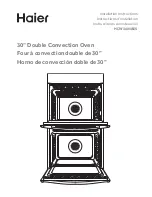
Cleaning and servicing
en
27
Using oven cleaner in a hot cooking compartment
damages the enamel.
▶
Never use oven cleaner in the cooking compartment
when it is still warm.
▶
Remove all food remnants from the cooking com-
partment and the appliance door before you next
heat up the appliance.
If different cleaning agents are mixed together, there
may be a chemical reaction between these.
▶
Do not mix cleaning agents.
▶
Completely remove any cleaning agent residue.
Salt contained in new sponge cloths may damage sur-
faces.
▶
Wash new sponge cloths thoroughly before use.
Suitable cleaning agents
Only use cleaning agents that are suitable for the differ-
ent surfaces on your appliance.
Follow the instructions on cleaning the appliance.
"Cleaning the appliance", Page 28
Appliance front
Surface
Suitable cleaning agents Information
Stainless steel
¡
Hot soapy water
¡
Special stainless steel
cleaning products
suitable for hot sur-
faces
To prevent corrosion, remove any patches of limescale, grease,
starch or albumin (e.g. egg white) from stainless steel surfaces im-
mediately.
Apply a thin layer of the stainless steel cleaning product.
Plastic or painted
surfaces
E.g. control panel
¡
Hot soapy water
Do not use glass cleaner or a glass scraper.
To avoid permanent stains, immediately remove any descaling agent
that gets onto the surface.
Appliance door
Area
Suitable cleaning agents Information
Door panels
¡
Hot soapy water
¡
Oven cleaners
Do not use a glass scraper or stainless steel wool.
Tip:
Remove the door panels in order to clean them thoroughly.
Door cover
¡
Made of stainless
steel:
Stainless steel cleaner
¡
Made from plastic:
Hot soapy water
Do not use glass cleaner or a glass scraper.
Do not use stainless steel care products.
Tip:
Remove the door cover for thorough cleaning.
Stainless steel in-
terior door frame
¡
Stainless steel cleaner Discolouration can be removed using stainless steel cleaner.
Do not use stainless steel care products.
Door handle
¡
Hot soapy water
To avoid permanent stains, immediately remove any descaling agent
that gets onto the surface.
Door seal
¡
Hot soapy water
Do not remove or scrub.
Cooking compartment
Area
Suitable cleaning agents Information
Enamel surfaces
¡
Hot soapy water
¡
Vinegar water
¡
Oven cleaners
Soak any heavily soiled areas and use a brush or steel wool.
Leave the appliance door open to dry the cooking compartment
after cleaning it.
Notes
¡
Enamel burns at very high temperatures, causing minor discol-
ouration. The functionality of your appliance is not affected by
this.
¡
The edges of thin trays cannot be completely enamelled and may
be rough. This does not impair the corrosion protection.
¡
Food residues leave a white coating on the enamel surfaces. The
coating does not pose a health risk. The functionality of your ap-
pliance is not affected by this. You can remove residues with
lemon juice.
Self-cleaning sur-
faces
-
Follow the instructions for self-cleaning surfaces.
"Regenerating self-cleaning surfaces in the cooking compart-
















































